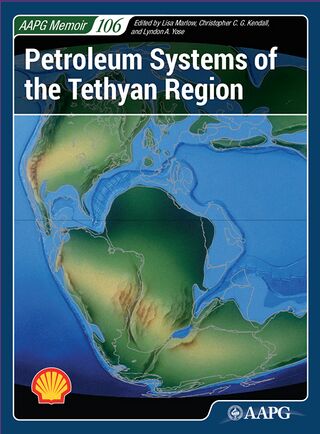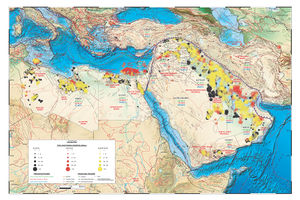Tethys region
| Petroleum systems of the Tethyan region | |

| |
| Series | AAPG Memoir |
|---|---|
| Chapter | Introduction |
| Author | Lisa Marlow, Christopher C. G. Kendall, and Lyndon A. Yose |
| Link | Web page |
| Store | AAPG Store |
The geology of the Arabian plate, North Africa and parts of Southern Eurasia are often discussed independent of one another. Our approach has been to step back and look at the region from a plate-scale geologic perspective. The present day Arabian and North Africa plates evolved together as a single unit from the Precambrian. They were physically connected as they moved around the globe from the southern polar regions to their present day position in the northern hemisphere, sub-tropical belt. Throughout the Phanerozoic, these plates have been on the margin of a series of Tethys seaways, including the Proto-Tethys, Paleo-Tethys, and Neo-Tethys. The common evolution of these plates along the Tethys Margin led to many similarities in the regional geology, including similar paleogeographic, tectonic, stratigraphic and depositional settings which, in turn, led to the development of similar petroleum systems. Though there are numerous similarities across the margin, variations occur too, and these can be compared in the chapters that follow. One primary difference across the region was the transition from uniform platform sedimentation which occurred across North Africa and Arabia, to intracontinental sub-basins and rift-basins (Arabian plate and North Africa, respectively) in the Permian, which led to “pots” of source rock across the Tethyan Margin.
Estimated recoverable reserves of countries along the Eastern and Western Tethyan Margins are shown in file:M106IntroFig01.jpbFigure 1. Many of the world’s giant and super-giant fields have been discovered in these various countries (Table 1). As shown in Table 1, these Tethyan countries account for 239 and 49 of the world’s giant and supergiant fields, respectively. There is a predominance of proven hydrocarbons on the former Eastern Tethyan Margin (Table 1). The Middle East region alone accounts for a significant amount of the global petroleum produced. The lack of giant and super-giant fields on the Western Tethyan Margin could in part be attributed to under exploration rather than less resource potential. Thus, identifying similarities across the Tethyan Margin and extrapolating known hydrocarbon systems to underexplored regions (onshore and offshore) will likely lead to more discoveries.
TABLE 1
